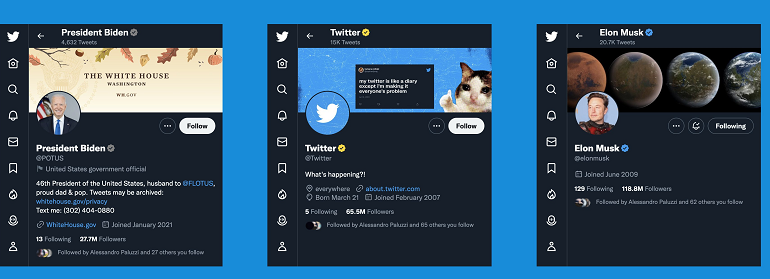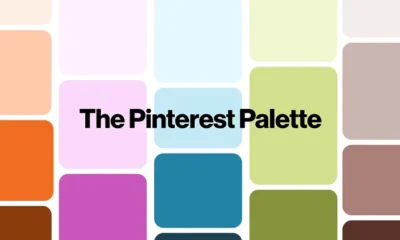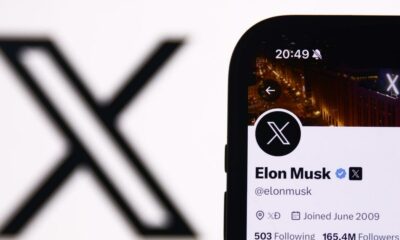SOCIAL
Elon Musk Outlines New, Alternate Color Checkmarks to Clarify Verification

Elon Musk has revealed more details of the coming revamp of Twitter’s $8 verification program, which was initially launched three weeks back, but then pulled from live production due to a raft of impersonations which caused significant confusion in the app.
Those impersonations also led to stock price dips, corporate apologies, misreporting – the $8 verification plan, while only available to some users, for a short amount of time, immediately caused significant issues for Twitter and it’s as partners.
So Elon and Co. took it back, in order to revise and re-shape the program in a more brand-safe, user-friendly way.
And now, Musk has revealed more details as to exactly how the updated $8 verification plan will work.
First, to limit the potential of misrepresentation of corporate and government accounts, Musk says that those profiles will now get a different colored checkmark, which will ensure that people can’t just buy a blue tick and then pretend to be Coca-Cola for example.
As per Musk:
“Gold check for companies, gray check for government, blue for individuals (celebrity or not)”
App researcher Alessandro Paluzzi posted these examples of how these new ticks might look in the app.
It’s a sensible move, which will avoid similar incidents like this tweet from an $8 verified account, which tanked Eli Lilly’s stock price.

The updated gold checkmark will ideally limit the potential for future users to do the same, because they won’t be able to buy the official gold tick – though there will be a period of adjustment and education on such for users.
The alternate checkmarks will also likely kill off Twitter’s new gray ‘Official’ tick, which looks pretty ridiculous.

Of course, the new variations of checkmarks do also add the potential problem of another elusive marker that people will be trying to get. But we’ll cross that extra complication when we come to it.
Another concern with this approach is that it’ll require manual checking, as Twitter can’t know for sure that it’s a brand or government account without some kind of confirmation.
Initially, Twitter has thus far opted to avoid any kind of manual confirmation in this new process, due to the additional labor requirement, but now, Musk says that this will be integrated into the updated process:
“All verified accounts will be manually authenticated before check activates. Painful, but necessary.”
How Musk and Co. do that with any level of efficiency, with 65% less staff, I don’t know, but it seems like they’re going to at least try to find a way to check each $8 subscriber before approving their blue tick.
Musk also noted last week that any change in user name will result in a blue tick being deactivated till Twitter approves the new name.
So, like, a lot of manual monitoring, with a lot less staff.
Also, for the traditional blue checkmarks, there’ll be no differentiation between those who’ve been given the marker, and those who’ve paid for it:
“All verified individual humans will have same blue check, as boundary of what constitutes ‘notable’ is otherwise too subjective.”
Which is true – there are a lot of blue checkmarks on random accounts, and it has been a confused system. But at the same time, there are also a lot of high-profile individuals who could be at risk of impersonation under this system – which, incidentally, is why the blue ticks were introduced in the first place (in 2009, an MLB star sued Twitter for allowing a scammer to use his likeness to dupe people in the app).
There’s also this:
“Individuals can have secondary tiny logo showing they belong to an org if verified as such by that org.”
So an additional qualifier for spokespeople, CEOs and journalists, as another measure to avoid impersonation.
The updated elements will certainly lessen the scope for scam activity, but still, they do also introduce a level of risk, and at the same time, the scheme itself is unlikely to work out as Musk hopes.
The revamp of Twitter’s verification program is Elon’s first grand plan to save the app (aside from cutting costs), by giving users access to one of the most in-demand in-app features – the elusive blue checkmark.
Charging for verification could theoretically kill two birds with one stone, in verifying real humans (while making it cost-prohibitive to crate bot accounts) while also providing a direct revenue stream, thereby reducing the company’s reliance in ads. People want the blue tick, now they can get it, while Musk has also sought to amplify the cultural divide element, by presenting this as a way to even the field, and enable all users to get what only celebrities have thus far been able to access.
Initially, Musk was set to charge $20 per month for this service, but after an argument with the author of ‘Misery’, he reduced this to $8 per month.
In Musk’s view, this is a good deal, because who doesn’t have an extra $8 to spend?
He’s since sought to establish this as the norm, repeatedly telling his critics to ‘now pay $8’, as if it’s a forgone conclusion that people will indeed pay.
But they won’t, and history shows that there’s almost no chance that Musk’s paid verification scheme will actually work as intended.
Take, for example, Twitter Blue, which provides Twitter users with a raft of additional features, which was initially available for $3 per month.
Twitter Blue never saw much take-up, peaking at 100k subscribers, with even the addition of tweet editing, the most requested feature in social media history, failing to shift the needle in any significant way.
Given this, it’s difficult to see Musk’s new, $8 verification getting the number of sign ups he’d need to achieve his aims for the option.
For context:
- If Elon wants to get subscriptions to contribute 50% of Twitter’s revenue, as he’s previously stated, he’ll need 24.6 million users to sign on to pay $8 per month for a blue tick
- If he wants to use this as a means to verify all the humans, so that only bot accounts are the ones that don’t have a blue tick, you’d think he’d be looking at upwards of 75% of Twitter’s user base, or around 178 million users paying each month
- Twitter’s likely to actually lose around $6 per US user, per month, for each person that signs up to the new $8 Twitter Blue scheme, due to Musk’s plan to show Blue subscribers ‘half the ads’. Factoring in App Store fees from the monthly $8 payment, it could actually be a difficult balance from a revenue standpoint, with Twitter potentially even losing money on the deal, if it does end up cutting ad exposure
- The majority of Twitter users are outside the US, where $8 per month could be a lot more cost-prohibitive. This is especially true in India, where most of Twitter’s growth has come from over the past three years. India now has 18.8m users making it Twitter’s third biggest audience market, and while Musk has also flagged variable pricing by region, even $1 per month could be too high for developing markets
Essentially, there’s no precedent to suggest that enough users will sign up to Elon’s $8 per month checkmark plan to make it worthwhile for the company to run, as either a revenue or verification pathway. Just 0.41% of Snapchat users pay for Snapchat+, a fraction of LinkedIn users pony up for Premium, while Meta concluded long ago that charging users was no where near as lucrative as serving a bigger audience more ads.
These new measures do counter some of the issues that the initial version of Musk’s $8 verification program introduced, but then again, they could also avoid them entirely by revising the current blue check system, as opposed to simply letting people pay for the marker.
But regardless, Musk is determined to push ahead, and find out for himself either way
Musk says the updated $8 verification plan will launch on Friday next week (12/2).
SOCIAL
Snapchat Explores New Messaging Retention Feature: A Game-Changer or Risky Move?

In a recent announcement, Snapchat revealed a groundbreaking update that challenges its traditional design ethos. The platform is experimenting with an option that allows users to defy the 24-hour auto-delete rule, a feature synonymous with Snapchat’s ephemeral messaging model.
The proposed change aims to introduce a “Never delete” option in messaging retention settings, aligning Snapchat more closely with conventional messaging apps. While this move may blur Snapchat’s distinctive selling point, Snap appears convinced of its necessity.
According to Snap, the decision stems from user feedback and a commitment to innovation based on user needs. The company aims to provide greater flexibility and control over conversations, catering to the preferences of its community.
Currently undergoing trials in select markets, the new feature empowers users to adjust retention settings on a conversation-by-conversation basis. Flexibility remains paramount, with participants able to modify settings within chats and receive in-chat notifications to ensure transparency.
Snapchat underscores that the default auto-delete feature will persist, reinforcing its design philosophy centered on ephemerality. However, with the app gaining traction as a primary messaging platform, the option offers users a means to preserve longer chat histories.
The update marks a pivotal moment for Snapchat, renowned for its disappearing message premise, especially popular among younger demographics. Retaining this focus has been pivotal to Snapchat’s identity, but the shift suggests a broader strategy aimed at diversifying its user base.
This strategy may appeal particularly to older demographics, potentially extending Snapchat’s relevance as users age. By emulating features of conventional messaging platforms, Snapchat seeks to enhance its appeal and broaden its reach.
Yet, the introduction of message retention poses questions about Snapchat’s uniqueness. While addressing user demands, the risk of diluting Snapchat’s distinctiveness looms large.
As Snapchat ventures into uncharted territory, the outcome of this experiment remains uncertain. Will message retention propel Snapchat to new heights, or will it compromise the platform’s uniqueness?
Only time will tell.
SOCIAL
Catering to specific audience boosts your business, says accountant turned coach

While it is tempting to try to appeal to a broad audience, the founder of alcohol-free coaching service Just the Tonic, Sandra Parker, believes the best thing you can do for your business is focus on your niche. Here’s how she did just that.
When running a business, reaching out to as many clients as possible can be tempting. But it also risks making your marketing “too generic,” warns Sandra Parker, the founder of Just The Tonic Coaching.
“From the very start of my business, I knew exactly who I could help and who I couldn’t,” Parker told My Biggest Lessons.
Parker struggled with alcohol dependence as a young professional. Today, her business targets high-achieving individuals who face challenges similar to those she had early in her career.
“I understand their frustrations, I understand their fears, and I understand their coping mechanisms and the stories they’re telling themselves,” Parker said. “Because of that, I’m able to market very effectively, to speak in a language that they understand, and am able to reach them.”Â
“I believe that it’s really important that you know exactly who your customer or your client is, and you target them, and you resist the temptation to make your marketing too generic to try and reach everyone,” she explained.
“If you speak specifically to your target clients, you will reach them, and I believe that’s the way that you’re going to be more successful.
Watch the video for more of Sandra Parker’s biggest lessons.
SOCIAL
Instagram Tests Live-Stream Games to Enhance Engagement

Instagram’s testing out some new options to help spice up your live-streams in the app, with some live broadcasters now able to select a game that they can play with viewers in-stream.
As you can see in these example screens, posted by Ahmed Ghanem, some creators now have the option to play either “This or That”, a question and answer prompt that you can share with your viewers, or “Trivia”, to generate more engagement within your IG live-streams.
That could be a simple way to spark more conversation and interaction, which could then lead into further engagement opportunities from your live audience.
Meta’s been exploring more ways to make live-streaming a bigger consideration for IG creators, with a view to live-streams potentially catching on with more users.
That includes the gradual expansion of its “Stars” live-stream donation program, giving more creators in more regions a means to accept donations from live-stream viewers, while back in December, Instagram also added some new options to make it easier to go live using third-party tools via desktop PCs.
Live streaming has been a major shift in China, where shopping live-streams, in particular, have led to massive opportunities for streaming platforms. They haven’t caught on in the same way in Western regions, but as TikTok and YouTube look to push live-stream adoption, there is still a chance that they will become a much bigger element in future.
Which is why IG is also trying to stay in touch, and add more ways for its creators to engage via streams. Live-stream games is another element within this, which could make this a better community-building, and potentially sales-driving option.
We’ve asked Instagram for more information on this test, and we’ll update this post if/when we hear back.
-

 SEO7 days ago
SEO7 days agoGoogle Limits News Links In California Over Proposed ‘Link Tax’ Law
-

 SEARCHENGINES6 days ago
SEARCHENGINES6 days agoGoogle Core Update Volatility, Helpful Content Update Gone, Dangerous Google Search Results & Google Ads Confusion
-
SEARCHENGINES7 days ago
Daily Search Forum Recap: April 12, 2024
-

 SEO6 days ago
SEO6 days ago10 Paid Search & PPC Planning Best Practices
-

 MARKETING6 days ago
MARKETING6 days ago2 Ways to Take Back the Power in Your Business: Part 2
-

 MARKETING4 days ago
MARKETING4 days ago5 Psychological Tactics to Write Better Emails
-

 SEARCHENGINES5 days ago
SEARCHENGINES5 days agoWeekend Google Core Ranking Volatility
-

 PPC6 days ago
PPC6 days agoCritical Display Error in Brand Safety Metrics On Twitter/X Corrected













You must be logged in to post a comment Login